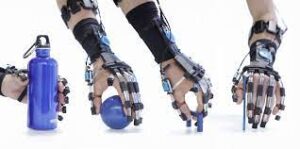Objective
The aim of this study was to understand the impact of training with a hand robotic device on hand paresis and function in a population of children with hemiparesis.
Methods
Twelve children with hemiparesis (mean age, 9 [SD, 3.64] years) completed participation in this prospective, experimental, pilot study. Participants underwent clinical assessments at baseline and again 6 weeks later with instructions to not initiate new therapies. After these assessments, participants received 6 weeks of training with a hand robotic device, consisting of 1-hour sessions, 3 times weekly. Assessments were repeated on completion of training.

Results
Results showed significant improvements after training on the Assisting Hand Assessment (mean difference, 2.0 Assisting Hand Assessment units; P = 0.011) and on the upper-extremity component of the Fugl-Meyer scale (raw score mean difference, 4.334; P = 0.001). No significant improvements between pretest and posttest were noted on the Jebsen-Taylor Test of Hand Function, the Quality of Upper Extremity Skills Test, or the Pediatric Evaluation of Disability Inventory after intervention. Total active mobility of digits and grip strength also failed to demonstrate significant changes after training.
Interpretation
Participants tolerated training with the hand robotic device, and significant improvements in bimanual hand use, as well as impairment-based scales, were noted. Improvements were carried over into bimanual skills during play.
American Journal of Physical Medicine & Rehabilitation. Bishop L, Gordon A. 96(1): p 1-7, January 2017
 Blog de Fisioterapia Fisioterapia
Blog de Fisioterapia Fisioterapia



